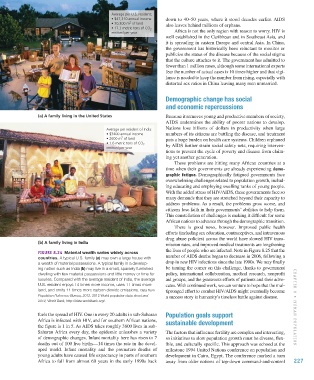Page 228 - Environment: The Science Behind the Stories
P. 228
Average per U.S. resident:
• $47,310 annual income down to 40–50 years, where it stood decades earlier. AIDS
2
• 30,300 m of land also leaves behind millions of orphans.
• 17.3 metric tons of CO 2 Africa is not the only region with reason to worry. HIV is
emitted per year
well established in the Caribbean and in Southeast Asia, and
it is spreading in eastern Europe and central Asia. In China,
the government has historically been reluctant to monitor or
publicize the status of the disease because of the social stigma
that the culture attaches to it. The government has admitted to
fewer than 1 million cases, although some international experts
fear the number of actual cases is 10 times higher and that vigi-
lance is needed to keep the number from rising, especially with
distorted sex ratios in China leaving many men unmarried.
Demographic change has social
and economic repercussions
(a) A family living in the United States Because it removes young and productive members of society,
AIDS undermines the ability of poorer nations to develop.
Average per resident of India: Nations lose billions of dollars in productivity when large
• $3400 annual income numbers of its citizens are battling the disease, and treatment
2
• 2600 m of land puts a huge burden on health care systems. Children orphaned
• 1.6 metric tons of CO 2 by AIDS further strain social safety nets, requiring interven-
emitted per year
tions to prevent the cycle of poverty and disease from claim-
ing yet another generation.
These problems are hitting many African countries at a
time when their governments are already experiencing demo-
graphic fatigue. Demographically fatigued governments face
overwhelming challenges related to population growth, includ-
ing educating and employing swelling ranks of young people.
With the added stress of HIV/AIDS, these governments face so
many demands that they are stretched beyond their capacity to
address problems. As a result, the problems grow worse, and
citizens lose faith in their governments’ abilities to help them.
This constellation of challenges is making it difficult for some
African nations to advance through the demographic transition.
There is good news, however. Improved public health
efforts (including sex education, contraceptives, and intravenous
drug abuse policies) across the world have slowed HIV trans-
(b) A family living in India
mission rates, and improved medical treatments are lengthening
the lives of people who are infected. Note in Figure 8.25 that the
Figure 8.24 Material wealth varies widely across
countries. A typical U.S. family (a) may own a large house with number of AIDS deaths began to decrease in 2006, following a
a wealth of material possessions. A typical family in a develop- drop in new HIV infections since the late 1990s. We may finally
ing nation such as India (b) may live in a small, sparsely furnished be turning the corner on this challenge, thanks to government
dwelling with few material possessions and little money or time for policy, international collaboration, medical research, nonprofit
luxuries. Compared with the average resident of India, the average aid groups, and the grassroots efforts of patients and their advo-
U.S. resident enjoys 14 times more income, uses 11 times more cates. With continued work, we can venture to hope that the mul-
land, and emits 11 times more carbon dioxide emissions. Data from tipronged effort to combat HIV/AIDS might eventually become
Population Reference Bureau, 2012. 2012 World population data sheet and a success story in humanity’s timeless battle against disease.
2012, World Bank, http://data.worldbank.org/.
fuels the spread of HIV. One in every 20 adults in sub-Saharan Population goals support CHAPTER 8 • Hum A n Po P ul AT i on
Africa is infected with HIV, and for southern African nations, sustainable development
the figure is 1 in 5. As AIDS takes roughly 3800 lives in sub-
Saharan Africa every day, the epidemic unleashes a variety The factors that influence fertility are complex and interacting,
of demographic changes. Infant mortality here has risen to 7 so initiatives to slow population growth must be diverse, flex-
deaths out of 100 live births—14 times the rate in the devel- ible, and culturally specific. This approach was echoed at the
oped world. Infant mortality and the premature deaths of milestone 1994 United Nations conference on population and
young adults have caused life expectancy in parts of southern development in Cairo, Egypt. The conference marked a turn
Africa to fall from almost 60 years in the early 1990s back away from older notions of top-down command-and-control 227
M08_WITH7428_05_SE_C08.indd 227 12/12/14 2:58 PM

